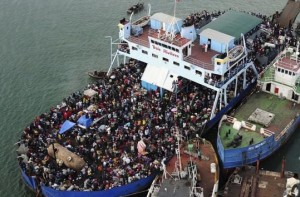‘South to south’ migration trend emerges
 A new global trend has emerged which sees migrants from poor countries moving to other impoverished societies – sometimes even poorer ones.
A new global trend has emerged which sees migrants from poor countries moving to other impoverished societies – sometimes even poorer ones.
Across the developing world, migrants move to other poor countries nearly as often as they move to rich ones. Yet their numbers and hardships are often overlooked.
Typically, they start off poorer than migrants to rich countries, earn less money and are more likely to travel illegally, which raises the chances of being abused.
They usually move to countries that offer migrants less legal protection and fewer services than wealthy nations do. Yet their earnings help sustain some of the poorest people on the globe.
The World Bank estimates there are 74 million “south to south” migrants – a term it uses to describe anyone moving from one developing country to another, regardless of geography.
The bank estimates that they send home $US18 billion to $US55 billion a year.
The bank also estimates that 82 million migrants have moved “south to north” – or from poor countries to rich ones.
Nicaraguans are building Costa Rican buildings, Paraguayans are picking Argentine crops, Nepalis are digging Indian mines, Indonesians are cleaning Malaysian homes and farm hands from Burkina Faso are tending the fields of the Ivory Coast.
Some save for more expensive journeys north, while others find that the move from one poor land to another will be all they can ever achieve.
And with rich countries tightening their borders, migration within the developing world is likely to grow.
“South to south migration is not only huge, it reaches a different class of people,” says US migration researcher Patricia Weiss Fagen.
“These are very poor people sending money to even poorer people and they often reach very rural areas where most remittances don’t go.”
For example, the Haitian migration to the Dominican Republic, its neighbour on the island of Hispaniola, has been significant, longstanding and fraught with strife.
The Spanish-speaking Dominicans still talk angrily about a Haitian occupation that ended in 1844.
The Creole-speaking Haitians still raise an incident in 1937, when a Dominican massacre along the border is estimated to have killed tens of thousands of Haitians.
Haitian workers started coming in large numbers nearly a century ago, as seasonal help in sugar cane fields. But many now work year-round on farms or urban construction sites – which raises their visibility and the chance for conflict.
Estimates vary greatly, but Dominican officials put Haitian migrants at one million, or 11 per cent of the population.
The Haitians say their problems are more than just hard work and low. They say their rights are being systematically violated.
Dominicans, they say, profit from their labour but deny them work rights and documentation, deport them at will and discriminate against them because of their darker skin.












